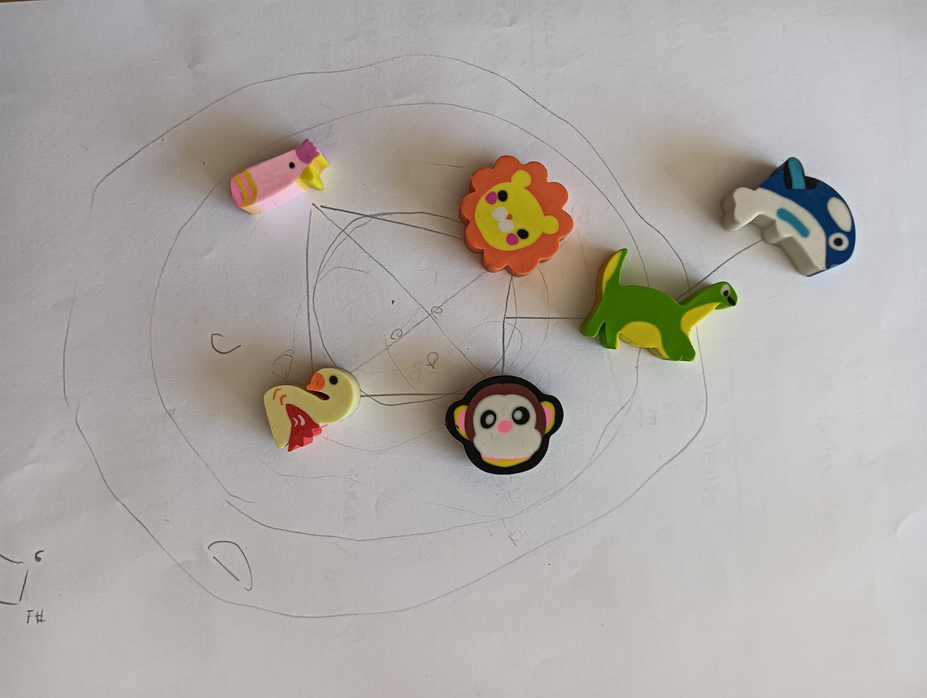*later, I would further develop this tool, finding exciting applications in the production of new electronic material. You can listen to some results HERE
Laboratory I
Small Groups (3-5 Instruments)
I initiated the laboratory sessions with small
groups comprising 3 to 5 musicians. I experimented
with ensembles of the same instrument family, such
as 3 pianos, 4 saxophones, 4 strings, 4 voices, etc.,
as well as heterogeneous combinations. I tested
various groupings to develop my ability to discern a
specific sound that aligned with the main requirements
I identified through the analysis conducted in the
previous semester. With fewer players, I could
concentrate on exploring timbre, articulations, and
traditional as well as extended techniques to achieve
the desired sonority. Part of this process involved direct
collaboration with the instrumentalists at the end of the
previous semester. I also organized specific meetings to
work on individual instrument preparations (To produce
and later analyze the glitch-electronic compositions (De-composition / Re-construction), I had to listen to them repeatedly, meticulously dissect and examine the music, notate it, and assimilate them. This process unconsciously created an archive, providing a model of examples I could reference, forming a rudimentary language pattern.
I recorded every session with a condenser microphone (AKG - 414 / AKG - 214 / NEUMANN TLM 103 / 102) for each individual instrument. This served the dual purpose of reviewing the music and creating a documentation of the process. Additionally, it allowed me to capture each sound with the perspective of potentially gathering new material that I could later process and re-edit, as in PART I of my project. Subsequently, I used the recordings of different ensembles as pieces of a puzzle that I could compose at my discretion. This involved experimenting with combinations of timbres and movements among instruments that had not traditionally played together. This approach expedited the overall process and provided me with a clear sense of the general picture, serving as an efficient tool for constructing the musical structure for my compositions.
I set up an audio interface with multiple outputs to send the different metronomic pulses independently to the musicians. Initially, I controlled the pulses using a MIDI generator in Ableton. Later, I developed a simple metronome device* in Max4Live for more precise control.
I aimed for the pulse to provide comfortable support for the musicians, typically using tempos ranging from 40 to 100 bpm. I experimented with various metronome intercorrelations, including sections where we started from the same bpm and then slightly diverged from it. I set each metronome differently with intervals of 2 to 5 bpm between them. This resulted in parts of the group playing at a slower tempo while others played at a faster tempo, and so on. The metronome provided them with a grid, and the challenge was to determine "what" and "how" they could move and expand within that framework.
The musicians who contributed to the laboratory include:
Darius Heid, Ginte PReisaite, Jacob PJ Fossum, Alex Ventling, Miguel Angel Crozzoli, Sölvi Kolbeinsson, Daniel Sousa, João Gato, Torstein Slåen, Antti Lähdesmäki, Karin Ingves, Sarvin Asa, Francesco Colocci, Lorenzo Colocci, Lone Aagot Meinich, Michaela Turcerova, Asger Thomsen, Luka Zabric, Asger Thomsen, Petter Asbjørnsen, Simona Guler, Irene Bianco, Ivar Myrset Asheim, Aurelijus Užameckis, Signe Christa Noah Andersen, Sofia Sá, Marijke Florien Maes, Susana Nunes, Mette Hommel Østerlund, Flavia Huarachi, Kim Mai Tich-Nguyen Thordsen, Marcus Wärnheim, Oscar Andreas Haug, Mark Ibsgaard Gregersen, Krzysztof Hadrych, Sarah Buchner, Ida Nørby, Rosanna Lorenzen, Jacob Kaarsberg, Laura Zöschg, Malina Midera, Jan Kadereit, Judith Parts, Tomas Gubbins

